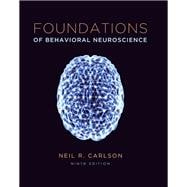Helps apply the research findings of behavioral neuroscience to daily life.
The ninth edition of Foundations of Behavioral Neuroscience offers a concise introduction to behavioral neuroscience. The text incorporates the latest studies and research in the rapidly changing fields of neuroscience and physiological psychology. The theme of strategies of learning helps readers apply these research findings to daily life. Foundations of Behavioral Neuroscience is an ideal choice for the instructor who wants a concise text with a good balance of human and animal studies.
MyPsychLab is an integral part of the Carlson program. Key learning applications include the MyPsychLab Brain.
Teaching & Learning Experience
- Personalize Learning – MyPsychLab is an online homework, tutorial, and assessment program. It helps students prepare for class and instructor gauge individual and class performance.
- Improve Critical Thinking –Each chapter begins with a list of Learning Objectives that also serve as the framework for the Study Guide that accompanies this text.
- Engage Students –An Interim Summary follows each major section of the book. The summaries provide useful reviews and also break each chapter into manageable chunks.
- Explore Theory/Research – APS Reader, Current Directions in Biopsychology in MyPsychLab
- Support Instructors – A full set of supplements, including MyPsychLab, provides instructors with all the resources and support they need.
0205962092 / 9780205962099 Foundations of Behavioral Neuroscience Plus NEW MyPsychLab with eText -- Access Card Package
Package consists of:
0205206514 / 9780205206513 NEW MyPsychLab with Pearson eText -- Valuepack Access Card
0205940242 / 9780205940240 Foundations of Behavioral Neuroscience








